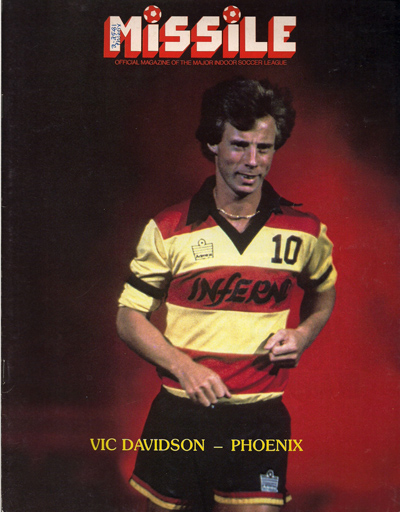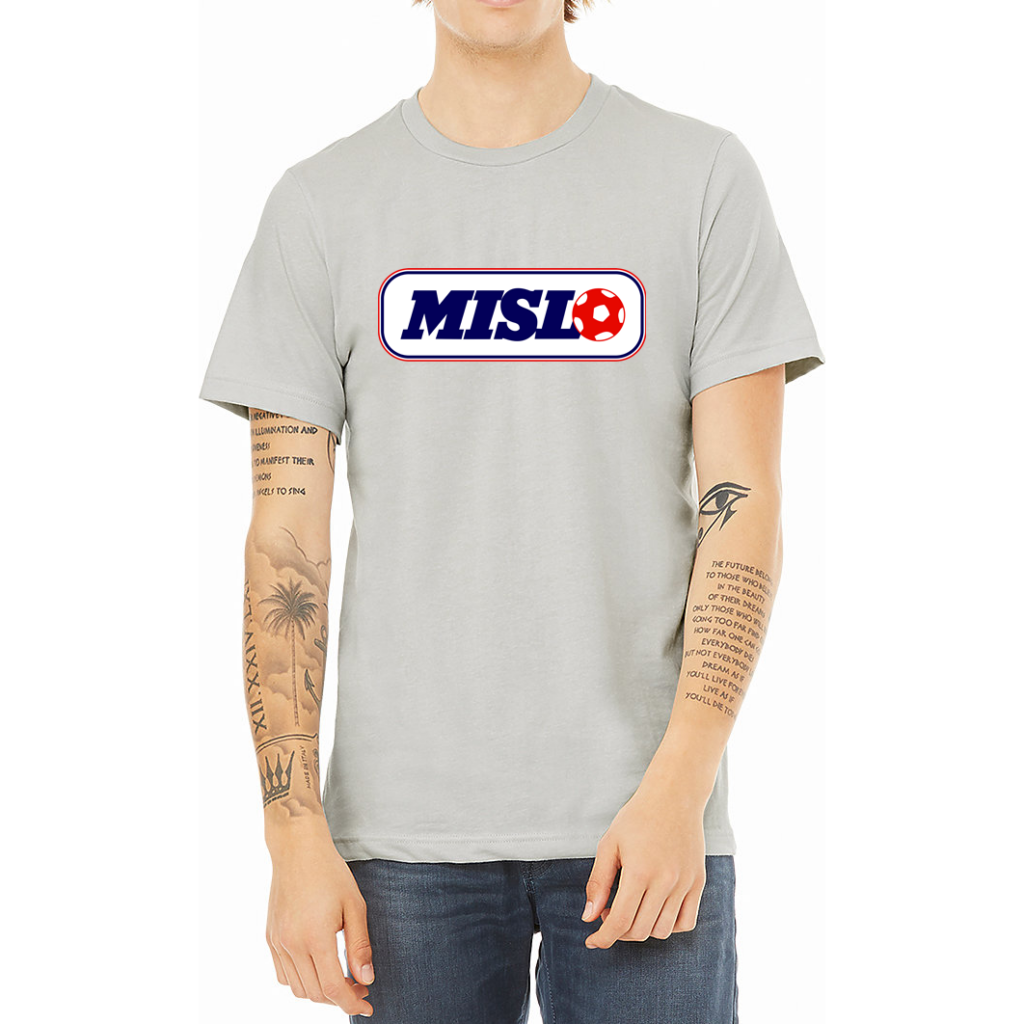Major Indoor Soccer League (1980-1983)
Tombstone
Born: May 30, 1980 – MISL expansion franchise
Re-Branded: July 13, 1983 (Phoenix Pride)1ASSOCIATED PRESS. “Phoenix MISL team to become ‘Pride'”. The Daily Star (Tucson, AZ). July 15, 1983
First Game: November 21, 1980 (L 6-5 vs. San Francisco Fog)
Last Game: April 16, 1983 (W 7-5 vs. Los Angeles Lazers)
MISL Championships: None
Arena
Arizona Veterans Memorial Coliseum (12,615)
Opened: 1965
Marketing
Team Colors: Red, Yellow & Black
Dance Team: The Sizzlers
Ownership
Owners:
- 1980-1981: Richard Ragone, Rogelio Novo, Emilio Palmar, Juan Cid, Manual Espinosa & Julio Eiroa
- 1982: Irv Berger, Rogelio Novo, Emilio Palmar, Juan Cid, Manuel Espinosa & Julio Eiroa
- 1983: Bruce Merrill
Bankruptcy Filing (December 15, 1982): Chapter 11
Sale (Jan. 1983): $175,000 (Bruce Merrill purchases the Inferno in U.S. Bankruptcy Court)2Nightengale, Bob. “MISL official says Earthquakes Phoenix-bound”. The Arizona Republic (Phoenix, AZ). August 7, 1984
Background
Remember that Churchill line about the Russians that Oliver Stone lifted for JFK? It’s a riddle wrapped in a mystery inside an enigma. It’s a sentiment often shared by fans and observers trying to discern the money men and financing schemes behind fringe pro sports operations.
The Vaids may have been poorly vetted absentee deadbeats, but they weren’t scary. Not scary like the reputed backers of the Major Indoor Soccer League’s Phoenix Inferno. This was a blackbox franchise whose personable front man Rick Ragone turned out to have little equity, but plenty of silent partners back in Scarface-era Miami.
Ragone’s story begins in Miami, where as a young man he worked as a PR assistant with the Miami Dolphins. In the early 1970’s Ragone hooked on in the front office of the Miami Toros of the North American Soccer League. He became an early proponent of the hybrid game of indoor soccer, played on carpeted hockey rinks.
At the Toros, Ragone crossed paths with Scottish-born executive Norm Sutherland. The two men kicked around the NASL for a few years and then teamed up to announce the formation of the indoor Major Soccer League in August 1975. Ragone and Sutherland envisioned their league as a summer time rival to the outdoor NASL and claimed they had franchises “90% sold” in six major markets. The project never made it off the drawing board, similar to other efforts that the young entrepeneurs tried to get off the ground in the late 1970’s. Ragone’s tried and failed to put an NASL franchise in sleepy Spokane, Washington. Sutherland promoted another abandoned indoor start-up, 1978’s Super Soccer League.
Nevertheless, Ragone and Sutherland were not the only people sold on indoor soccer in the Seventies. Two other men, Ed Tepper and Earl Foreman, succeeded in launching the first legit indoor league, the Major Indoor Soccer League, in December 1978. The MISL debuted with six teams in major East Coast and Midwest cities. Rapid expansion followed. The MISL announced Phoenix, Arizona as the league’s 12th franchise on May 30th, 1980 to begin play that November. Ragone would be the President and purported owner. He tabbed Sutherland as the Head Coach & GM of the club, dubbed the Phoenix Inferno.
The Inferno debuted at the Arizona Veterans Memorial Coliseum on November 21st, 1980, losing 5-4 to the San Francisco Fog before an announced crowd of 11,098. Sutherland lasted only half the season in the Head Coach role, posting an 8-19 record before getting replaced by player-coach Adrian Webster. But Ragone didn’t jettison his old colleague – Sutherland retained his GM role in the front office. The Inferno finished their first season at 17-23, good enough to squeak into the playoffs. They lost in the first round to the defending champion New York Arrows. At the box office, the Inferno claimed attendance of 152,309 for 21 dates for an average of 7,253.
Tragedy truck barely a month into the Inferno’s second season on December 22, 1981. Ragone perished along with his father in a four-car accident in Paradise Valley, Arizona. A San Francisco real estate investor named Irv Berger stepped in and assumed control of the franchise in January 1982.
Under Berger, the financial fortunes of the Phoenix Inferno swiftly plummeted. By December of 1982, just 11 months into his ownership, the Inferno owed more than $110,000 in back payroll taxes to the federal government and another $26,000 to the Arizona Department of Revenue. On December 13th, 1982, IRS agents raided the team offices, seized all the cash on the premises and slapped on the padlocks. A bankruptcy court sold a controlling stake in the club to Arizona cable television pioneer Bruce Merrill in January 1983 for $175,000. Under Merrill’s financial stewardship the once-bankrupt Inferno were able to complete the 1982-83 MISL season.
After getting out from under his Inferno financial woes, Irv Berger gave an interview to The Arizona Republic in February 1983 revealing more details of the Inferno’s financial history and ownership structure. Despite Ragone’s public representations, the majority ownership in the club during Ragone’s (and later Berger’s) tenure was held by a group of Cuban exiles in and around Key Biscayne and Hialeah, Florida.
The group included the Reverend Manuel A. Espinosa, a controversial right wing radio host in Miami with ties to the anti-Castro paramilitary leader and accused terrorist Dr. Orlando Bosch. Espinosa was profiled in Soldier of Fortune magazine in 1980. Two other Inferno investors, Rogelio “Roger” Novo and Emilio Palmar co-owned Roger’s-on-the-Green, a golf course restaurant and lounge in Key Biscayne, Florida. In 1982, Ricardo “Monkey” Morales was shot in the head and killed there during an argument with another patron. During the 1960’s and 1970’s Morales was involved with violent anti-Castro mercenaries. He simultaneously worked as an informant for the CIA, FBI and DEA. By his own admission, Morales was part of the October 1976 bombing of Cubana Air Lines flight 455 in the sky off Barbados, also tied to Bosch. The bombing killed 73 people on board including all 24 members of Cuba’s Olympic gold medal fencing team. Conspiracy theorists have speculated on Morales as a possible participant in various Cuban exile scenarios of the JFK assassination.
The Arizona Republic article cited accounts from Inferno staff members that Ragone would periodically fly off to Miami and return with “suitcases full of cash”. For his part, Berger came off as somewhat rattled by the experience. Noting that he only met one of the Cubans (Novo) one time, Berger told the paper: “I hear this group is very dangerous. You better watch your step. They’re very heavy people.”
Meanwhile, back in Phoenix, Bruce Merrill set about re-branding his formerly bankrupt club. He fired Norm Sutherland and replaced him with former San Diego Clippers (NBA) GM Ted Podleski. Podleski, a conservative Christian, blanched at the Inferno name and replaced it with the dullest identity imaginable: for the 1983-84 season, Arizona’s MISL entry would be known as the Phoenix Pride. Podleski also dispensed with the Inferno’s flashy yellow, red & black color scheme and substituted coloring more suitable to his bland new vision: beige.
The 1983-84 Phoenix Pride campaign was an unmitigated disaster for all involved. The club finished in 6th (last) place in the MISL’s Western Division with an 18-30 record. Merrill, for his part, lost $2.2 million operating the Pride, a figure that United Press International sportingly referred to as “a league record”. In June 1984, Merrill announced the club would fold if he could not find a Greater Fool buyer within one month. Failing to do so, he terminated his membership in July 1984.
##
At least some members of the group of Cuban exiles behind the Phoenix Inferno were, in fact, “very heavy people”, as Berger had warned.
Rogelio Novo, the Inferno investor and restauranteur who witnessed Morales’ killing, met a gruesome end of his own in January 1985. He died of a shotgun blast to the head and his body was dumped in an undeveloped area in Pembroke Pines, Florida.
Another Cuban exile Inferno investor, Reverend Manuel Espinosa, was politely asked to move out of his Hialeah, Florida housing unit after components for an unexploded bomb were discovered beneath his car in 1983. He died of natural causes in the late 1980’s.
After the Pride folded in 1984, pro indoor soccer returned to Phoenix with the Arizona Sandsharks of the Continental Indoor Soccer League in 1993. That club lasted five seasons from 1993 to 1997.
Phoenix Inferno Shop
Our Favorite Stuff
MISL Logo T-shirt
The Major Indoor Soccer League (MISL) kicked off in 1978 with six teams. At its peak, it boasted 14 teams with many drawing sell-out crowds. Remember the MISL in the great logo T-shirt from Royal Retros. Available in white and navy blue too!
In Memoriam
Owner Rick Ragone (Inferno ’80-’81) died in a two-car accident in Paradise Valley, Arizona on December 22, 1981. Ragone was 36 years old. His father also perished in the crash, along with the driver of the other car.
Part-owner Rogelio Novo (Inferno ’80-’82) was shot to death in Pembroke Pines, Florida in July 1985. As of 2002, his murder remained unsolved.
Defender Clive Charles (Inferno ’81-’82) died of prostate cancer on August 26, 2003 at age 51. Los Angeles Times obituary.
Owner Bruce Merrill (Inferno/Pride ’83-’84) passed away on February 13, 2011 at age 92. Phoenix Business Journal obituary.
Downloads
2018 FWiL Interview with Phoenix Inferno bankruptcy trustee Charlie Evranian (Inferno story starts p. 10)
Links
###



5 Responses
I jave cleaned out a storage unit, with a Inferno hat, and several Inferno button pins, with pictures of players on them !! They look like 1970’s to 1980’s !! Anyone collecting these player 1 1/2″ to 2″ button type pins ?? Make me an offer, at hauljunkman@ yahoo.com.
I was a Phoenix Inferno Cheerleader for the 1982 season. Veteran’s Memorial Coliseum was always packed and the games were thrilling! From my perspective, everything seemed above board and the cheerleaders were treated with respect.
There may have been organized crime types (I never saw anything) in management, but I know for a fact that fugitive members of the IRA were in the audience a number of times, owing to their association with a Phoenix Inferno Cheerleader!
Did you know Goal Keeper Nick ‘Nicko’ Owcharuk? High string Ukrainian dude.
We were good friends when he played for the NASL franchise ‘The Tulsa Roughnecks’. Nick and I traveled the country the Summer of 1982, doing the National Football League Player’s Associations Unions for Youth Programs. Houston, New Orleans, Cleveland, and Chicago where we stayed with his parents. He was a friend, and the last time I saw him was at his wedding in San Diego. Got him work on Francis Coppola’s, ‘The Outsiders’, in Tulsa 1983.
I worked there. It’s true and more. One of my co workers went to NY and told the story on Good Morning America. David Hartman, conducted the interview. Pissed them all off.